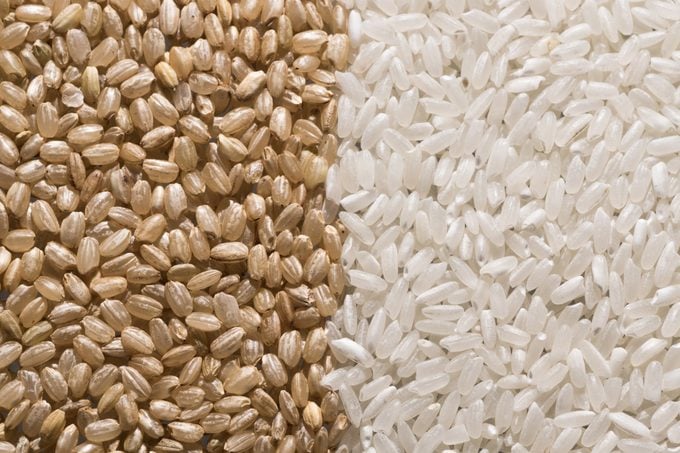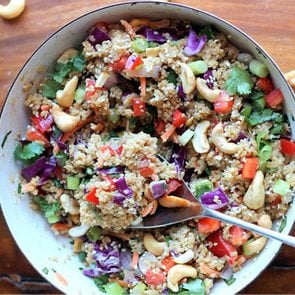Brown Rice vs. White Rice: Which Is Healthier?
Updated: Mar. 14, 2022
Rice is the perfect carb-loaded complement to almost any veggie and high-protein diet or meal. Registered dietitians explain the difference between brown rice and white rice, including their nutrition, calories, and which is better for your health.
Brown rice vs. white rice
Why is rice the perfect pantry staple? Let us count the ways. For starters, rice is a versatile grain that goes with any number of cheap, healthy meals.
It stays fresh and edible for years when stored properly. It comes in many varieties (such as jasmine or basmati) and types (such as short, medium, and long-grain).
Plus, rice is generally gluten free, which means it doesn’t include wheat and other grains like barley, rye, and oats.
Rice is a member of the grass family, which includes foods like maize and sugar cane. The two types of rice that get the most buzz are brown rice and white rice.
You’ve probably heard that brown rice is healthier than white rice. But it’s not as cut-and-dried as you might think. First, it’s important to understand the differences between the two.
All white rice actually starts out as brown rice and undergoes a milling process that strips away the outer husk, bran, and germ of each grain, leaving only the endosperm, says Malina Malkani, RDN, a registered dietitian nutritionist in Westchester, New York.

Where does rice come from?
To grow rice, water-soaked seeds are first planted in a prepared bed, says Lisa DeFazio, RDN, a registered dietitian nutritionist in Los Angeles.
The seedlings go in a paddy field, which is “a flooded field of arable land used for growing semiaquatic crops,” explains DeFazio. “When the grains begin to ripen, the water is drained from the fields.”
Harvesting begins when the grain turns yellow, and the plants droop. Then the rice is harvested by hand or machine and usually dried in the fields under the sun.
Brown rice calories and nutrition facts
Brown rice has more fiber, vitamins, and minerals than its white counterpart. This is the nutrient breakdown for one cup (202 g) of cooked, long-grain brown rice.
- Fat: 1.9 g
- Calories: 248
- Sodium: 8 mg
- Carbohydrates: 52 g
- Dietary fiber: 3.2 g
- Protein: 5.5 g
- Calcium: 6 g
- Iron: 1 g
- Magnesium: 7.8 mg
White rice nutrition facts
This is the nutrient breakdown for one cup (158 g) of cooked, long-grain white rice.
- Fat: 0.4 g
- Calories: 205
- Sodium: 1.6 mg
- Carbohydrates: 45 g
- Dietary fiber: 0.6 g
- Protein: 4.3 g
- Calcium: 15.8 mg
- Iron: 1.9 mg
- Magnesium: 19 mg
Brown rice, blood sugar, and type 2 diabetes
One of the easy ways to increase fiber in your diet is by adding in brown rice. It has about five times the fiber and slightly more protein, calories, and vitamins than white rice.
This is part of why brown rice is generally healthier for people with diabetes, says DeFazio. According to a review of studies in the European Journal of Epidemiology, high-fiber whole grains like brown rice may help lower blood sugar levels and lower the risk of type 2 diabetes.
Simply swapping from white rice to brown rice may help prevent type 2 diabetes. (Type 1 diabetes, an autoimmune disease, can’t be prevented with dietary changes.)
Research in Diabetes Technology & Therapeutics found that replacing white with brown rice lowers blood sugar levels and decreases the risk of type 2 diabetes.
“White rice can raise blood sugar quickly, while brown rice has a lower glycemic index and causes a slower rise in blood sugar,” DeFazio explains.
Brown rice and heart disease
Eating brown rice might help reduce the risk of heart disease—thanks to its many powerful antioxidants—and may lower LDL (“bad”) cholesterol, according to research in the American Journal of Clinical Nutrition and the journal Food and Science Nutrition.
Brown rice is rich in lignans, which are associated with reduced cholesterol and lower blood pressure, according to a study in Nutrition Review. And it’s a rich source of magnesium, an essential nutrient for heart health.
A review of studies, published in 2016 in Journal of Trace Elements in Medicine and Biology, found that an additional 100mg of magnesium per day reduced the risk of heart disease mortality in women.
Brown rice and weight control
People who want to control their weight might have better luck with brown rice. A study of almost 30,000 adults and 15,000 children, published in 2016 in Nutrition Journal, found that the more whole grains participants ate, the lower their body weight.
Another trial on 40 overweight and obese women, published in the International Journal of Preventative Medicine, found that those who ate brown rice not only lost weight, but they reduced their waist size, too, in comparison to those who ate white rice.
Brown rice and kidney disease
Because brown rice is high in phosphorus and potassium, it needs to be portion-controlled or limited for those on a renal diet for kidney disease, says DeFazio.
“People with kidney disease need to follow a kidney-friendly diet to avoid the buildup of certain nutrients in the blood,” she explains. “During chronic kidney disease, the kidneys cannot remove excess sodium, potassium, and phosphorus from the body. So these patients are at a high risk of elevated blood levels of these minerals.”
A renal diet usually involves limiting sodium and potassium to 2,000 mg per day and limiting phosphorus to 800–1,000 mg per day.
Brown rice and digestive issues
Although fiber is an important part of a healthy diet, some people may need to go easy on this nutrient.
“Individuals with intestinal and or digestive issues such as irritable bowel syndrome (IBS) and or small intestinal bacterial overgrowth (SIBO) may benefit from avoiding the fiber in brown rice for certain periods of time,” Malkani says.
In those cases, white rice might be a better choice.
Brown rice and arsenic
According to DeFazio, rice accumulates higher amounts of mercury and arsenic, compared to other crops often grown in polluted areas.
“All cereal grains easily take up arsenic when in the soil, but it is higher in rice compared with wheat and barley,” she says.
The Food and Drug Administration reports that arsenic is more likely found in brown rice than white since arsenic accumulates in the bran.
White rice and energy
White rice digests quicker because of its lack of fiber. This isn’t great for people with diabetes. But it is good for athletes and weightlifters who often prefer the high glycemic value of white rice, instead of brown rice, to provide quick energy for workouts and help support muscle recovery.
“Athletes prefer white rice as it is easier to digest, does not cause gastrointestinal issues like gas and bloating, and does not block the ability to absorb micronutrients as brown rice does,” DeFazio says.
Most white rice produced in the U.S. is enriched to add thiamin (vitamin B1), iron, and folate back into it, leaving it nutritionally greater in these vitamins compared to brown rice, she adds.
Bottom line: There could be a place in your diet for both
Defazio loves rice and eats both depending on her mood. “Brown rice has a chewy texture, but I prefer white rice,” she says. “I eat it with vegetables for my fiber.”
Another tip for white rice lovers: Eating protein with rice slows down the rise in blood sugars.
Malkani likes to provide various textures and flavors for her kids to widen their palates. “To that end, we tend to cook whole grains, including brown rice, for our family meals and enjoy white rice when eating out or ordering in,” she says.
Whether or not you opt for brown or white rice depends on both your health and taste preferences.






















